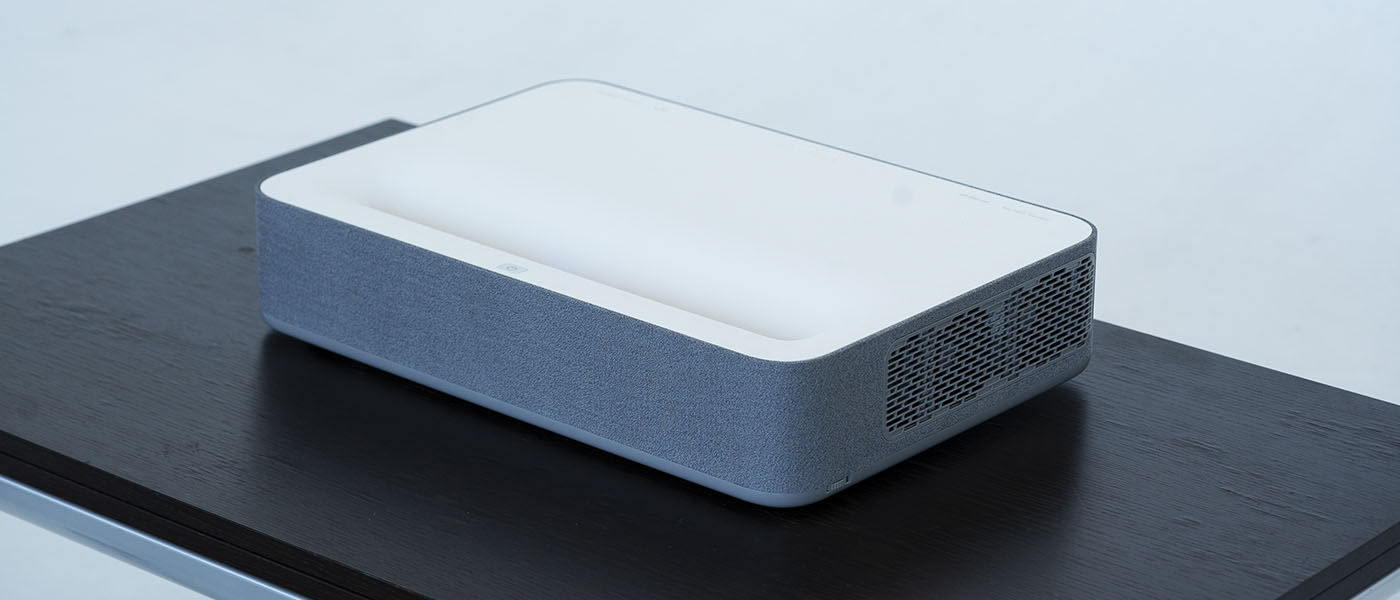
It throws an image up to 200 inches and accepts 1080p signals through its two HDMI ports. It also has a built-in speaker with a headphone jack. Sporting a compact and lightweight chassis, it can be toted from place to place in its included soft carry bag. A DLP light engine with an LED rated at 40,000 hours means no maintenance is required. The best part is it only costs $110 online.
Vankyo Leisure 420 DLP Projector
- 420p native resolution
- DLP/LED light engine with 40,000-hour service life
- Built-in speaker
- Compact and lightweight
- Includes carry bag and HDMI cable
- Only costs $110
If you’ve browsed the projector section on Amazon, you’ve no doubt seen the super-cheap models for sale there. It’s amazing how many products there are for less than $200. Though I’ve reviewed a few projectors that sell for under $1000, I’ve never had one in my theater that cost just $110. You read that right, the Vankyo Leisure 420 DLP Projector I’m checking out today is just $110.
Now for a bit of up front – I cannot be hyper-critical of a projector that costs only $110. Though I will be performing my usual suite of tests on it, the results should be taken in context. The Leisure 420 only costs $110. While it is indeed a DLP projector, it won’t provide the performance and image quality of something closer to the $1000 price point. It does, however, offer convenience and ease-of-use in a compact and lightweight chassis. They even sell a 120-inch screen to go with it for just 30 bucks. Honestly, I don’t know what to expect so let’s take a look.
Type:
single-chip DLP
Native resolution:
720×480, 16:9 aspect ratio
Image size:
40-200 inches
Lamp:
LED
Video connections:
2x HDMI, 1x VGA
Additional connections:
1x USB, 3.5mm audio in/out, SD card
Lamp service life (mfr):
40,000 hours
Dimensions:
12 x 4.33 x 8.18 inches (WxHxD)
Weight:
2.9lbs
Warranty:
Three years
Price:
$109.99
Company:
SECRETS Tags:
vankyo, leisure 420, dlp projector, projector, Projector Review 2019
- BenQ MH530FHD Compact DLP Projector Review
- BenQ GP20 Ultra-Lite LED-lit-DLP Projector Review
- Epson Home Cinema 640 Compact LCD Projector Review

For starters, the Vankyo Leisure 420 is not a high-def display. Though it accepts signals up to 1080p/60Hz, its native resolution is 480p. That means at larger image sizes, you may see a screen-door effect. It may be more or less visible depending on your screen material. If you use a white wall with a bit of texture on it, the pixel gaps aren’t as obvious. On a high-quality Stewart Filmscreen like my reference model, they are easy to see from 10 feet back in an 80-inch diagonal image.
Secrets Sponsor
The light engine is a single-chip DLP with an LED lamp. Service life is rated at 40,000 hours. Cooling is provided by a small fan which isn’t too loud but if you sit close to the projector, it is audible. Venting is to the side and I was pleasantly surprised to see no light leakage there. The chassis is sealed fairly well.
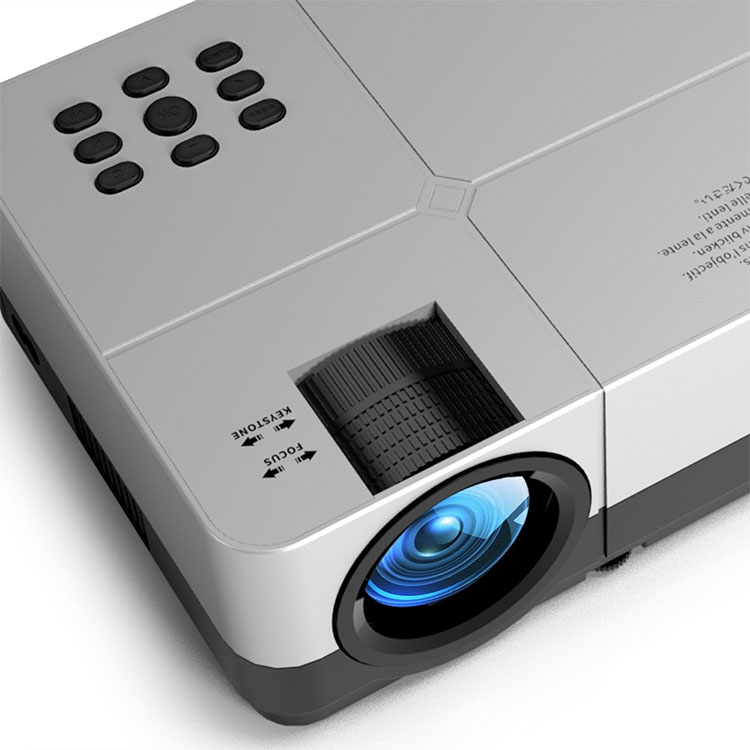
Up top there are mechanical adjusters for focus and keystone correction. There is no zoom and as I quickly discovered, no lens offset. That means the image is projected equally above and below the lens axis. This creates a challenge for installation since you can’t really put it on a coffee table or hang it close to the ceiling. Though the Leisure 420 supports inverted projection, you would need a very long pipe on your mount to get the projector low enough for a normal screen height. While I wouldn’t expect lens shift for $110, a proper lens offset would go a long way toward making this projector more flexible and easier to use.
There is no zoom available, so you’ll have to control image size with throw distance. I set it up at eight feet from my screen and got a picture about 80-inches diagonal. That’s as large as I recommend given the resolution and low brightness. The Leisure 420 can only muster around 20 nits and pulling the unit back will just make the picture dimmer.

A small well-designed remote handles control duty. It isn’t backlit, but the buttons glow for a short time after you turn the lights off. It has a powerful IR emitter which effectively bounces commands off the screen to a front-mounted receiver. You get only what’s needed which is source selection, menu navigation, and a power toggle.
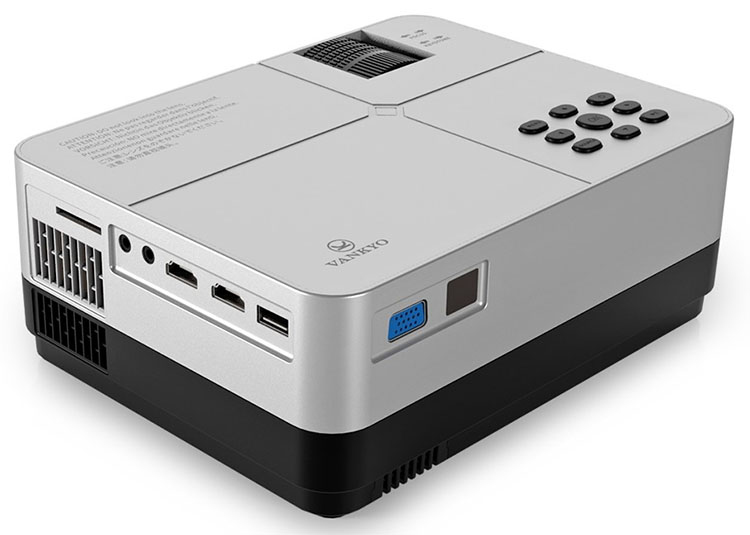
Speaking of sources, the Leisure 420 can interface with just about anything. There are two HDMI ports, a VGA input, and USB. You also get an SD card reader. It will accept streaming sticks like Amazon Firestick or Roku. Or you can hook up a Blu-ray player as I did. If you have an analog component, it can connect to the VGA port either directly or with a breakout cable. Audio support comes from a built-in speaker along with 3.5mm jacks for headphone output and analog input.
Vankyo also sent me a 120-inch screen with the review sample. It came in the form of folded fabric in a stout ziplock bag. It has no tensioning system; rather, it’s designed to be hung on a wall with the included hooks. It appears to have a roughly 1.0 gain and it is nicely made. It’s a far better solution that simply projecting on a bare wall which can introduce visible texture into the image. Vankyo’s screen is a no-brainer addon at just $30 online.
Without lens offset, it’s a bit challenging to get the image centered on a screen installed at a normal height. If you put the Leisure 420 on a coffee table, part of the picture may wind up on the floor. If you want to ceiling mount, you’ll need an extension to get it low enough. I settled for a telescoping stand that placed the projector four feet off the ground. At an eight-foot throw distance, the image was around 80 inches diagonal.
Hookup was a breeze. There were no issues with either my Accupel signal generator or an OPPO UDP-203 Ultra HD Blu-ray player. I experimented with different signal formats to see what best-suited the projector’s native 480p resolution. I found that it made no difference whether I fed a native 480p signal or 1080p. In all cases, I could not resolve a one-pixel multi-burst pattern in either luma or chroma modes. The pixel gap was visible on my Stewart screen as a subtle screen-door effect.
The menu system is quite simple but offers basic image controls in the User picture mode. That’s the only way to adjust brightness, contrast, and sharpness so you’ll want to use that mode even if you don’t calibrate. White balance can be adjusted with a single-point RGB control, but I found it had too little range to completely remove a blue tint from the Leisure 420’s grayscale. Also missing are gamma presets, and they are sorely needed. You can see my detailed test results in the On The Bench section.
Calibration was quick and easy and though I didn’t quite reach the Rec.709 spec for color, grayscale, or gamma, I was able to improve image quality from the default state. I also discovered a Just Scan option in the Aspect Ratio menu. You’ll want to choose that one as it significantly improves resolution. With adjustments complete, it was time for a few movies.

I started with the best possible material from my library. Planet Earth II is reference video by which all other content should be judged. How it looked on the Leisure 420 depended on the particular scene I watched. Detailed objects like the hairy sloth in episode one looked surprisingly good. While no one will mistake it for true 1080p, I was able to pick out fine hair along with the dirt and grass stuck to the creature’s coat. Slow camera pans were reasonably smooth though I saw some subtle hitches as the 24p material was converted to 60Hz. All three primary colors had a natural look with lush green trees, clear blue skies, and warm tones from sunlit landscapes.
Next up was Incredibles 2. Digital animation makes any display look good, but I saw moiré artifacts that indicate signal compression. The Parr family’s red uniforms were blotchy rather than smoothly-toned. But wide shots in the city looked good with a decent contrast level. Motion resolution was first rate as it is with any DLP. There was no blur in evidence. And despite the Leisure 420’s low light output, the image was not hard to watch.
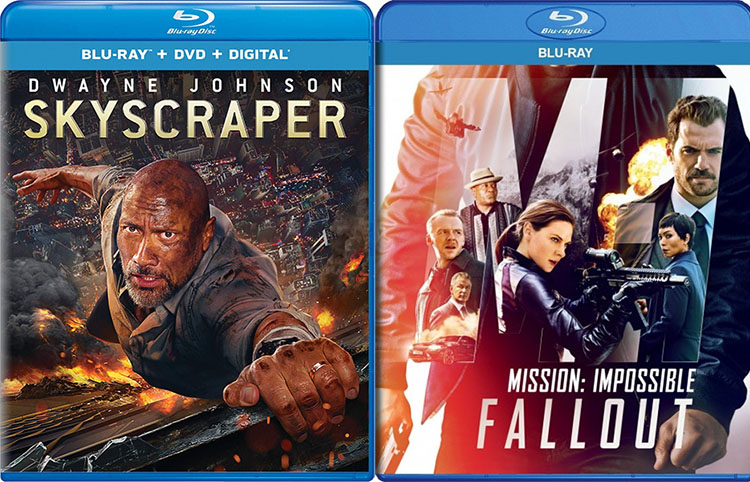
Fire is a particularly difficult test for any display. Often, you can see macro-blocking or moiré, but the Leisure 420 managed it well. Even when the camera panned quickly in Skyscraper, the flames didn’t break up. I was also impressed at how clear the sweat looked on Dwayne Johnson’s face and bald head. Though there isn’t a lot of contrast here, the highlights popped nicely.
Secrets Sponsor
I finished my viewing with the latest Mission Impossible chapter, Fallout. I wanted to see how a few night scenes panned out. Black levels are a weakness for any DLP and the Leisure 420 is no exception. You will want to adjust the brightness control as recommended below to achieve optimal contrast but the best I could manage was 157.4:1. That’s not as bad as it sounds. Though black never dropped below a dark gray, DLP’s solid intra-image contrast kept the picture lively and engaging. And as in the other films, motion resolution remained rock-solid with no evidence of blur.
After viewing a few test patterns, it was obvious to me that the default Standard picture mode with Medium color temp was far too cool. Checking out some video clips showed me a flat image with a distinct blue tint and very little contrast. Therefore, rather than measuring the Leisure 420 in its out-of-box mode, I switched the picture preset to User and the color temp to warm. I strongly suggest you do the same, or better yet, use the settings I’ll provide at the end of this section.
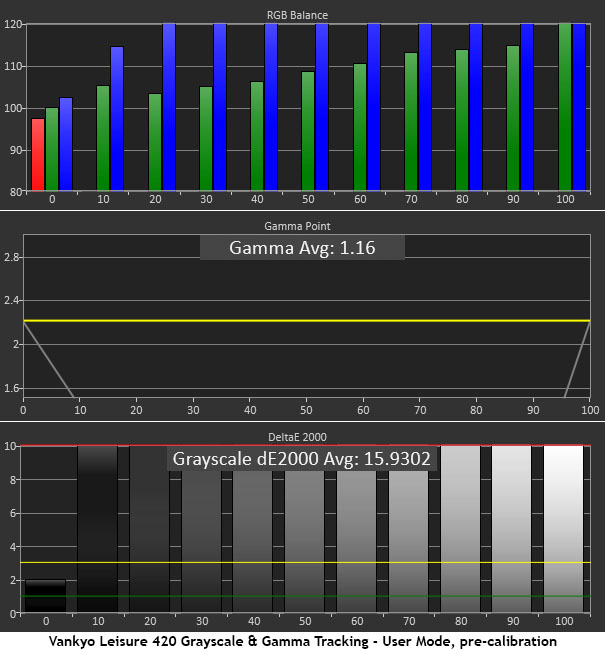
Even at the warm color temp preset, the picture looks very blue and flat. Gamma tracking is almost linear which further reduces perceived contrast. There is also a fair amount of clipping at the brightest steps which blows out highlight detail.
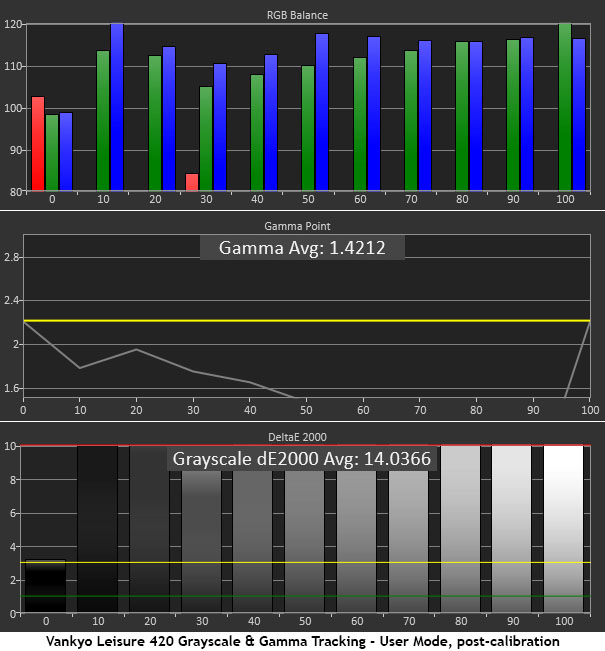
The user color temp offers a single-point adjustment but there isn’t enough control range to achieve a 6500K average. By turning red to the max and zeroing out blue, I was able to reduce the average from 12,000K to around 8,000K. The change in DeltaE isn’t significant but the image looks far more natural. I also adjusted brightness and contrast to maximize dynamic range. That change improves gamma in the darker steps which lowers black levels and brings out more shadow detail.
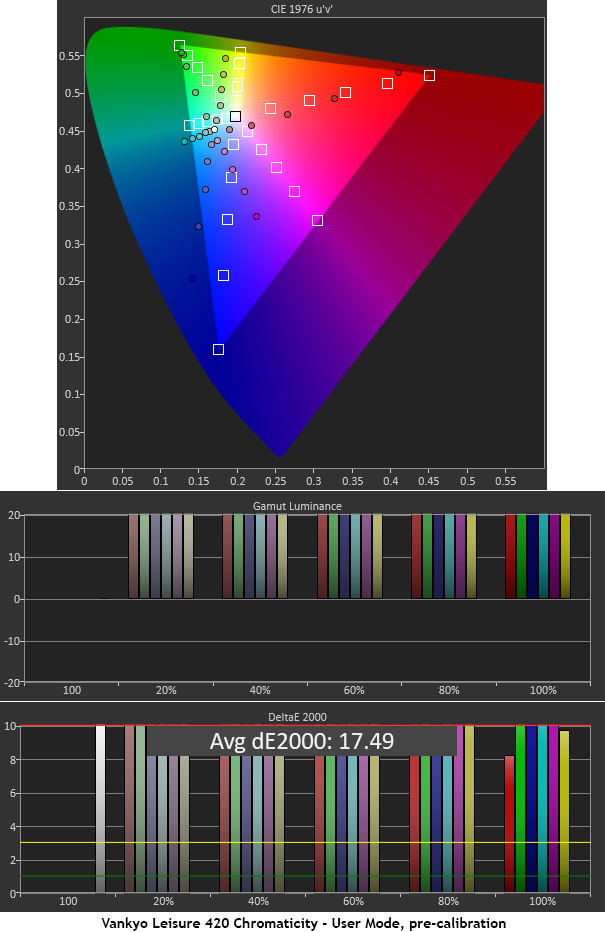
The Leisure 420 is a Rec.709 projector but its primaries are under-saturated, only rendering around 72 percent of the gamut. Blue lies outside the triangle in hue which helps that color look a little better. Saturation tracking is reasonably consistent from the center of the triangle outwards.
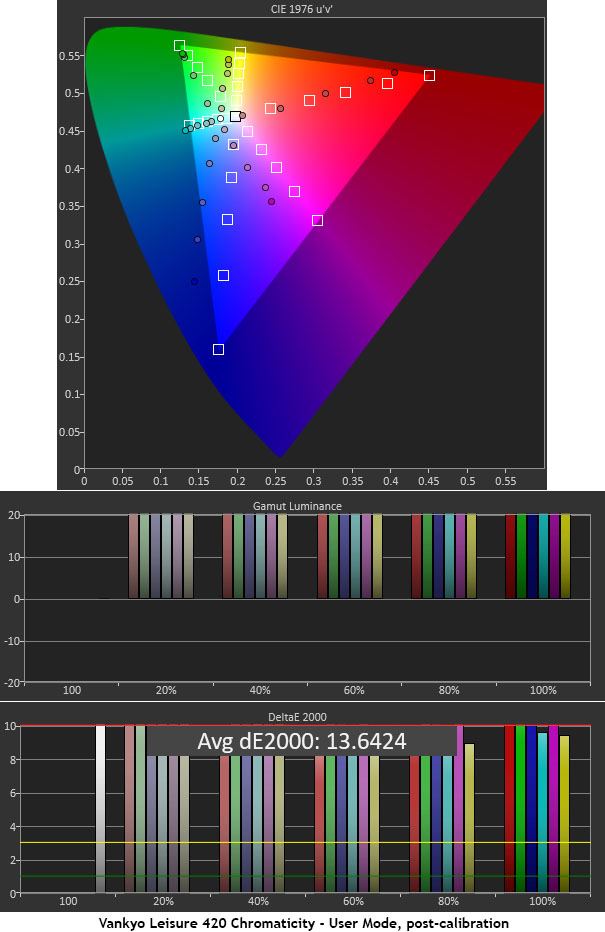
The increased gamma, along with better white balance brings most color points closer to their targets. The gain in accuracy is small but easily seen by the naked eye. If the RGB controls had greater range, it would be possible to dial in a proper D65 white point. And better gamma tracking would aid color accuracy. I tried increasing the color slider in hopes of improving saturation, but it only damaged the tracking and caused detail clipping at medium brightness levels. It’s best to leave that control alone.
Here are the settings I used for the review. They will make a significant improvement in contrast and overall image quality.
- Picture Mode User
- Contrast 47
- Brightness 44
- Color 50
- Sharpness 15
- Color Temp User
- Red 100
- Green 61
- Blue 0
- Aspect Ratio Just Scan

The Leisure 420 projector has a native resolution of 480p but will accept signals up to 1080p/60Hz. I tried both resolutions and neither would pass a one-pixel multi-burst, either luma or chroma. The projector also clips all white signals above digital level 220, regardless of signal format. Video processing is non-existent. 24p material shows subtle jerking which indicates the framerate is being converted to 60p on the fly. Interlaced sources exhibit moiré and breakup. The jaggies test failed solely based on resolution but you can improve detail rendering by reducing the sharpness slider to 15. Higher settings produce visible edge enhancement.
All luminance values are expressed here in nits, also known as candelas per square meter (cd/m2). For those needing a frame of reference, 1fL equals 3.43 nits, or 1 nit equals .29fL.
Vankyo claims 3200 lux (lumens per square meter) output for the Leisure 420. I was unable to measure anywhere close to that. On my Stewart Studiotek 130 screen, with an 80-inch diagonal image size, the best I could do while rendering all possible detail was 20.5381 nits. Combined with a black level of .1305 nit, the contrast ratio was 157.4:1. You can get a little more light in the Vivid picture mode, 26 nits, but then black levels are so high that contrast drops to just 73.7:1. The brightness slider is unavailable in that mode so I don’t recommend it.

It’s hard to fault any projector that only costs $110. Though the VANKYO LEISURE 420 DLP PROJECTOR cuts a few corners, it still delivers a decent image and easy setup.
- Easy setup and installation
- Reasonable image quality at small screen sizes
- 40,000-hour LED light source
- Compact and light with included carry case
- Lens offset for easier installation
- Gamma presets
- More range in the RGB controls
So, what can one say about a projector that costs $110? I think Vankyo has managed to deliver decent performance for the price. While the Leisure 420 gives away resolution and color accuracy to more expensive projectors, it manages to deliver a decent big-screen experience. Its DLP chip works well at keeping motion resolution high and even though it doesn’t correctly process 24p, I didn’t find the conversion to 60Hz to be a problem. I also surprised that its low light output didn’t reduce my enjoyment. Though it would be nice to have higher brightness, it provides enough juice for darkened rooms at screen sizes up to 80 inches.
Some videophiles with premium displays installed in their homes may wish for a portable solution; a way to take their entertainment on the road. The Vankyo Leisure 420 is not for those buyers. You will not mistake its image for 1080p and it is too far from SMPTE color standards to satisfy picky viewers. But if you are just looking for some way to bring a few movies along on your next trip and don’t have much space to pack your tech gear, the Leisure 420 is convenient and offers solid performance.


